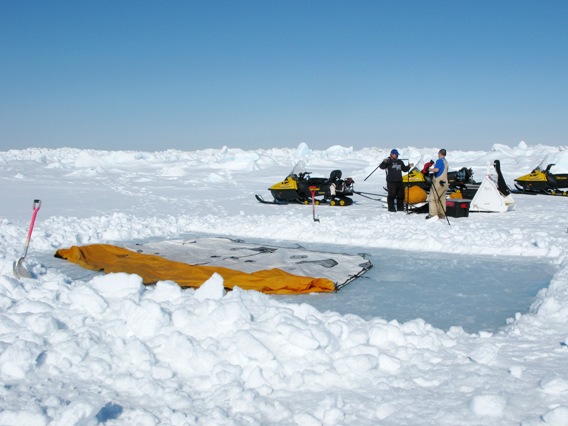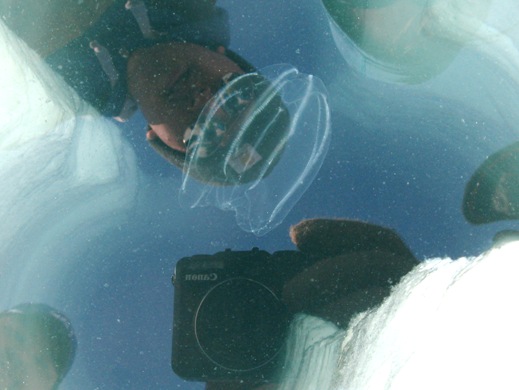Today was another lab day, and although our special pipettes still hadn’t arrived we felt we had to go ahead and process our RNA samples. During our first trip to Barrow last spring we had experimented with holding these samples until we got home before processing them. The results were not good, and so we decided that we had to process the samples as soon as possible after they were collected. We felt it was risky to even holding the samples a single extra day so we moved ahead using our back-up pipettes. But can you believe?! Exactly as Zac was finishing-up with the extractions the pipettes were delivered. The only saving grace was that both Zac and I had both missed lunch and when we unpacked the box and found the Twizzlers and peanut m&m’s that Victoria had used as packing material we were thrilled. Thanks Vic!
While Zac was hard at work in the lab purifying RNA, I spent the morning and most of the afternoon out on the ice helping to move our ice camp. During our last trip in January we were unable to reach our primary sampling site about 1.5 miles offshore due to ice conditions and the lack of a suitable ice trail, so we had to settle for a location closer in. The water there was quite a bit shallower. Although all our measurements indicated that we still were in oceanic and well-mixed water, we can’t be certain that we can directly compare the data from that site to all the rest of the data that we are generating. So during the planning for the current trip we had decided that if we managed to get two samples from our primary site and we still had time during this trip, that we would move our camp and sample from the more inshore location.
Sampling both locations at essentially the same time will allow us to directly compare results from both the near shore and offshore locations. We’re hoping they are similar!
All has gone well, so today we began to implement our decision and moved our ice camp inshore. With Rachel Siple, myself, and the UMIAQ crew, we headed out on the ice. Reaching our destination we drilled an exploratory hole in the ice and measured the water depth and ice thickness. We’re really looking for 10 meters of water, but our minimum is 8. Unfortunately at the first hole we drilled we only had 7M of water so we were a bit disappointed. From experience we knew that the bathymetry in this area is highly variable so we moved about 30 meters from the first hole and drilled another. At this location we measured the water depth to be a little over 8 meters. Although marginal, it met our criteria. We are still hoping to find a better site. We got back on our snow machines and moved to the other side of a very large ice ridge and drilled a third exploratory hole. Alas, the depth was even less there so we decided to go ahead and set-up camp at the second place we looked.
Setting-up camp involves removing the snow from the area (lots of shoveling); positioning holes for the pump inlet and outlet (for the big tent) and a large hole to accommodate the Niskin bottle in the small tent; and documenting water depth, ice thickness, water temperature, salinity, and light attenuation. It’s especially important that we know light attenuation since we need this information in order to set-up our incubations back in the lab and to decide at what depth to sample.
All this was pretty hard, manual labor and, to my surprise, I found myself sweating and discarding some of my layers of clothes despite the cold temperatures.
Drilling all those holes was especially hard work and made me appreciate more than ever the support we are receiving from our UMIAQ logistics team.
While drilling one of the holes we had a visitor from a ctenophore. I sent this picture to a colleague Jenny Purcell and she identified it as Bolinopsis infundibuluma common Arctic species of ctenophore.
Jenny is a world renowned jellyfish authority from Western Washington University. Ctenophores, commonly known as comb jellies are almost all predators that feed on small zooplankton. Their most distinctive features are their “combs” which consist of cilia that they use for swimming. Interestingly, ctenophores are the largest animals that swim by means of cilia. Bolinopsis is commonly found throughout the Arctic Ocean in the upper 500 meters and subsists on small zooplankton species like copeopods. Undoubtedly this individual was enjoying eating all the organisms growing at the bottom of the ice pack and we must have disturbed his/her lunch when we drilled our hole. I say his/her because Bolinopsis is a hermaphrodite.
By about 2pm we were finished and headed back and I arrived just in time to watch Zac finish his lab work and eat Twizzlers.
For dinner Steven Baer (a Ph.D. student with Debbie Bronk) and I had planned a Shabbat dinner for everyone. We are Jewish and enjoy the ritual of Shabbat that marks the end of the week and gives us all a moment to stop and reflect on the many blessings of our lives. Steven prepared an awesome dinner of pasta primavera and hosted us all to dinner. Steven had also brought candles from home and I managed to bring a bottle of wine. Because we can’t buy wine (or any alcohol) in Barrow (at least not legally) I had to smuggle it in. In the local grocery store we found a loaf of bread that resembled a Challah. Challah is a type of bread traditionally served at festive Jewish meals.
So, with everyone in attendance we took a moment to pause our work, say a few prayers, and enjoy a fantastic meal together. It didn’t last long though since most of us had to run off to finish something or other, and to get ready for tomorrow’s sampling expedition. But at least it was a moment.






